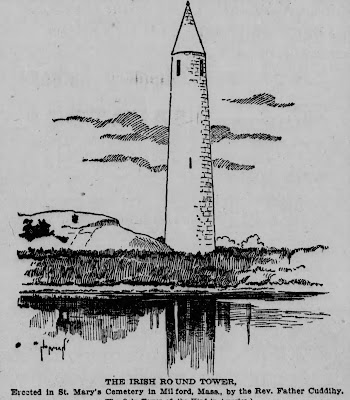Massachusetts’ Irish Round Tower in Milford Build by 19th Century Irish Immigrants

The town of Milford Massachusetts has its own iconic Irish Round Tower, built in the 19th century by Irish immigrants who came to the Blackstone Valley Region to work in the rock quarries and on railroad construction.
The Milford tower is about 65 feet high and 16 feet in circumference. Early media reports suggest that the tower was modeled after the notable round tower in Glendalough, County Wicklow; the Milford tower is approximately half the size of Glendalough.
Round towers were monastic structures dating back to the 9th century in Ireland. The Irish monks likely used them for defense from invaders, as well as for solace and contemplation, and for storing valuable objects like bells, religious artifacts and hand-written manuscripts. Because of their slenderness, many were destroyed by lightning or even high winds.
Today there are approximately 65 round towers in Ireland, in various states of condition, but many of the well preserved as historic architecture or sacred sites.
The Milford tower was the brainchild of Irish immigrant priest Reverend Patrick Cuddihy, pastor of St. Mary's Church for more than four decades, arriving there in 1857. St. Mary's Cemetery dates back to the 1830s and was one of the early Catholic cemeteries in Massachusetts, and a final resting place for thousands of immigrants fleeing the Irish Famine of the 1840s.
The tower was highly praised when it was built. In 1895, The Boston Post wrote, “The tower is the first of its kind ever built in this country and will stand for ages like a sentinel watching over the city of the dead."
According to records at St. Mary’s Church in Milford, Father Patrick Cuddihy was born in Clonmel, Tipperary in spring 1809. He became a Franciscan priest and worked in local parishes in Waterford for about two decades. After deciding to do pastoral work in the United States, Cuddihy arrived in New York in 1852. He made his way to Boston to meet with Bishop Fitzpatrick, who dispatched him to the city of Pittsfield in the Berkshires to tend to a growing congregation of Irish living in western Massachusetts. There, Cuddihy built churches in Great Barrington, North Lee and North Adams, before moving to Milford in 1857.
He built St. Mary’s in Milford, which opened on Christmas Day, 1869.
In the 1880s, Cuddihy purchased additional land to expand the cemetery, and it was during this time that he conceived of the idea of building a round tower there.
The very best Milford pink granite was used in the construction of the tower,” wrote the Milford Daily News in a 1974 article. “The tower ends in a conical cap bearing a large granite facsimile of a shamrock. A small entrance at the base of the tower gives access to a maze of ladders leading to the windows just below the crown.”
When Cuddihy died in December, 1898 he was buried at the base of the tower.
Since 1998, a volunteer group called The Friends of Old Saint Mary's Cemetery led by Barbara A. Minnihan has worked in the historic four-acre cemetery to identify old gravestones, maintain and upgrade the cemetery grounds.
For more information about Irish heritage sites in greater Boston, visit IrishHeritageTrail.com.




My name is Christopher Silvestri, I am an eagle scout in Milford. The addition of the path, the rocks, the new bench and the door was a part of my Eagle Project and I am very happy to see a picture of the work I did on this sight.
ReplyDeleteChris thanks for your note. And congratulations on the great work done by the Eagles in Milford!
ReplyDelete